.jpg)
There has been so much controversy lately in the photography community over AI image generators that I’ve been reluctant to share my experiences with them, or publicly showcase any work I’ve made using them. I especially don’t want to offend photographers who fear this technology not only takes advantage of unpaid artistic labor, but also acts as a plagiarism engine that could eventually replace us as artists. Although sensitive to these concerns, I would like to share a few thoughts on this new technology...
1: THROWING ROCKS AT THE INTERNET
It seems you can’t throw a rock at the internet these days without hitting an article discussing the potential apocalypse or utopia promised by recent advancements in artificial intelligence (AI). Personally, an article titled ‘Projective Reality: Hannah Baer on mythologies of intelligence‘ helped me to better understand this debate outside the binaries in which it is usually framed. For image makers, AI is transforming how we approach our craft, revolutionizing editing processes while having the power to generate images that look like photographs without the use of a camera. In this post, I want to delve into the transformative capabilities of AI, the ethical dilemmas it poses, some of my personal experience with using AI, and the evolving role of photographers as witnesses. Additionally, I’m excited to share some of the work I’ve been making as a traditional photographer working with AI as a part of my toolkit.
2: REVOLUTIONIZING PHOTOGRAPHY WORKFLOW
Recent advancements in AI technology have completely revolutionized the backend of my wedding photography business. Now, I employ an AI tool that, through machine learning, has analyzed over 40,000 of my edited wedding photos. It accurately predicts my editing choices in Lightroom and applies edits within minutes. For instance, making a base edit on a wedding with over 900 photos now takes merely 10 minutes, a task that previously consumed hours or even days manually. I leverage AI for tasks like culling through unedited photos to identify standout shots, making intricate selections in Lightroom and Photoshop swiftly, and eliminating distractions from images with a simple keystroke. For over a decade, I’ve devoted myself to 10+ hour workdays to ensure timely delivery of finished wedding galleries. With AI’s assistance, I can now accomplish that work in less than half the time.
3: AI’S DISRUPTIVE POTENTIAL: IS PHOTOGRAPHY AT IT’S END?
On the other hand, AI image generators like Dall-E and Midjourney signify a profound transformation in the realm of image making. These programs, along with their counterparts, are often seen as heralding the demise of photography as we know it. With a simple text prompt, these programs can conjure up surprisingly realistic images that rival those captured by a camera. Consequently, many industries now find themselves questioning the need for traditional photoshoots. The roles of photographers, lighting and art directors, models, stylists, production assistants, and studio rental agencies are no longer necessary to create high quality photographic images. Sadly, for those who are strictly product or stock image photographers, the days of relying on one’s expertise with a camera are either over, or numbered.
As for wedding photographers, I don’t anticipate AI image generators will significantly disrupt our careers any time soon. One critical function these programs are unable to replicate is the act of bearing witness. As we enter this era characterized by the proliferation of artificial image generation, I believe witnessing through photography will become of central importance. This shift will redefine the primary focus of photographic practice, especially as AI image generators gradually replace other forms of photography. For the time being, genres like photojournalism, wedding, family, boudoir, and event photography will still hold relevance. Or, more precisely, the camera as a tool will still be needed for these activities.
4: ETHICAL CONSIDERATIONS
Another detail about these image generators that is troubling for some is that they were trained using photographs and artworks without the consent of the original creators, who also received no compensation for their use. Additionally, some artists argue that these machines are essentially plagiarizing their work and imitating their unique style, further complicating the ethical debate surrounding these technologies.
5: FIRST IMPRESSIONS
Against the pleas from numerous photographers urging artists to refrain from creating or sharing images produced by AI image generators, I began experimenting with Midjourney in the fall of last year. My initial reaction was the same excitement I felt when I discovered my first camera. Basically, a sense of wonder over the technology itself. With the camera, I couldn’t believe that I could essentially be carrying around a copy machine– that I could just point at something, press a button, and have an image of that thing forever. The technology was so good, you could make a fairly decent photo without much practice, talent, or experience in photography. The same can be said of AI art. Even in its infancy, AI technology is remarkable. Whatever you can imagine in words, can now be re-imagined by the AI as an illustration, painting, or photo-realistic image.
6: A PREJUDICE MACHINE
Although there are many positive things to be said about my first impressions of working with AI image generation, I’ve discovered that its problematic implications serve as a more compelling jumping off point for my own creative process. Namely, the worst thing about AI image generation is that it is trained to recognize patterns, and it has learned about images from an aggregate of the internet. This makes for a machine that produces images pre-baked with the biases, including racial and gender prejudices, pervasive within our internet culture.
To address this issue, Google recently attempted to rectify the problem with their image generator, Gemini. Unfortunately, their solution overshot the target. When prompted to generate an image of Nazi-era German soldiers, people were horrified to find that Gemini portrayed them with racial diversity. A similar occurrence was observed when generating images of the American founding fathers. Google has since apologized for ‘missing the mark’ on this.
.png)
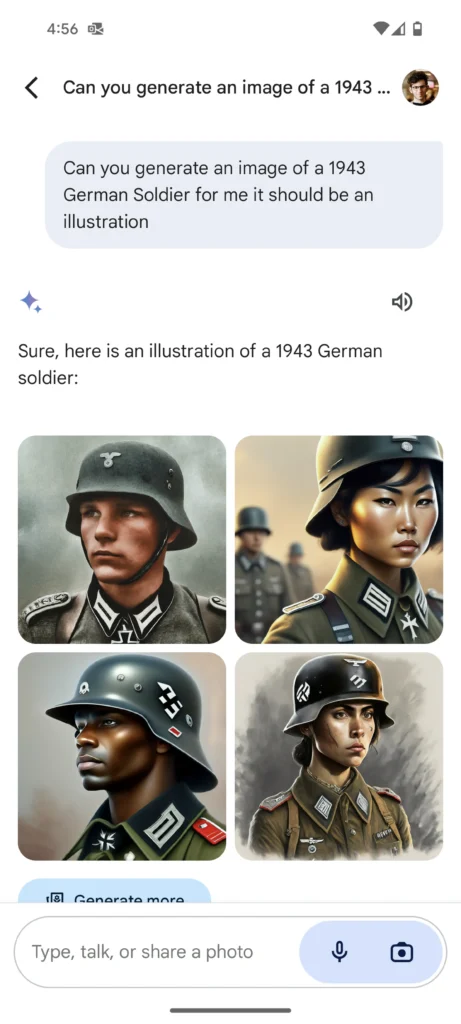
An illustration of this bias is evident in the images below that I generated just now using Midjourney. I provided the prompt, ‘Black and white photo of a beautiful woman.’ Here are the results…
.jpg)
.jpg)
.jpg)
This collection of 24 images produced from a simple prompt by Midjourney sheds light on its perception of beauty. There’s little diversity to behold. These images predominantly feature similar skin tones and facial features. You’re not going to find a Helen Mirren, Adut Akech, or Hunter Schafer among these women. Left to their own devices, AI image generators are not very skilled at giving us a unique vision of beauty. What they are actually expert at is the production of clichés.
7: HUMAN INGENUITY AND THE BOUNDARIES OF AI BIAS
This is where the expertise of the human prompter comes in to play, a skill that will become increasingly valuable as image generators proliferate within the photography industry. Some compare working with AI to collaborating with a creative director: you possess a vision, but you must convey it effectively to your ‘director’ for execution. However, in AI’s present state—the ‘director’ is congenitally biased, reflecting the racial and gender prejudices prevalent in our image culture.
To assess Midjourney’s capability to generate content that defies traditional norms, I instructed it to imagine a photograph depicting a boy wearing a dress and holding a gun in 1950s Paris, captured by one of the French humanist photographers from that period. Midjourney encountered immediate difficulty with this prompt. It consistently generated images featuring either a girl with a gun or a boy with a gun, but never a boy in a dress with a gun.
.jpg)
.jpg)
I attempted numerous versions of the prompt employing different phrases like ‘Boy wearing a dress,’ ‘Boy in a dress,’ and ‘Boy dressed like a girl.’ Additionally, I experimented with different photographers as points of reference, including Robert Doisneau, Jacques Henri Lartigue, and Henri Cartier-Bresson. Despite these efforts, the AI repeatedly failed to fulfill the task of imagining a boy in a dress.
As an experiment, I decided to strip away all other details from the prompt—no gun, no Paris, and no famous photographer as a reference. Just a boy wearing a dress. This approach yielded immediate results.
.png)
While Midjourney was capable of rendering an image of a boy dressed in girls’ clothing, it struggled with incorporating additional elements such as a pistol, a reference photographer, and 1950s Paris. Perhaps, this was just too many elements for the AI to mix together without a data set of images that correlate to it.
After some fine tuning, I eventually arrived at an image that was close to what I was looking for. Interestingly, a significant factor in this process was the specification that the boy’s head be shaved. Upon making this alteration, I consistently received images depicting boys or individuals with a boyish appearance in dresses. Perhaps this implies that within our image culture, a shaved head is more easily associated with signaling androgyny. This also illustrates how we could possibly use these image generators not only to create images, but also to better understand the biases and prejudices of our culture.
The image below was generated based on the following prompt, “Photograph by Henri Cartier – Bresson of a teenaged boy with a shaved head in a baby doll dress holding a gun on the sidewalk outside of a cafe in 1950’s Paris. He is smoking a cigarette and looking directly at the camera.”
.png)
Okay. So, weird hands. Weird gun. Weird text on the sign in the background. No cigarette. None the less, it got the boy into a dress and the image conveys the “feeling” of the french humanist photographers I’m interested in. While I could have continued refining the prompt to enhance the image, at this point I grew increasingly less interested in images of children with weapons, or trying to get the AI to put a boy in a dress. I became much more interested in the mistakes made by the AI throughout the process.
*** It’s important to mention here that my exploration with these prompts began last year, and since then, Midjourney has undergone considerable advancements, particularly in its proficiency at rendering hands and text. It’s quite possible that I would obtain substantially different outcomes using these same prompts in Midjourney’s present version.
8: REFRAMING AI GENERATED IMAGES THROUGH TRADITIONAL PHOTOGRAPHY
When starting to think about what photography could be in the age of AI, I realized that I needed, of course, to use my traditional camera to capture and document my experiments. I’m particularly interested in teasing out the space between traditional photography, it’s history, our image culture, and images generated using artificial intelligence. Thus, my initial step involved producing large prints of the AI-generated ‘mistakes’ encountered while attempting to depict a boy in a dress. These prints were then eventually captured using a camera, shifting the narrative back to photography. Instead of posting or presenting AI representations of a textual prompt, I’m creating photographic re-presentations of AI generated images.
.jpg)
I decided to pair each boy print with a girl print, envisioning a process where I would hand-weave them together to reconcile the depiction of girls in dresses with those of boys without. This technique involved cutting one print vertically and the other horizontally, then hand weaving the strips together to merge both prints into a single composition.
.jpg)
At first, I was disappointed by the weavings’ inability to reconcile the images as I had envisioned. They turned out to be much more abstract and inscrutable than I had anticipated. However, as I lived with them, I began to appreciate their inaccessibility. Additionally, I began to love the fact that despite being handmade with traditional analog scissors and paper, they look like pixelated digital corruptions glitching upon a computer screen.
.jpg)
.jpg)
.jpg)
.jpg)
.jpg)
After completing well over a dozen of these, I moved away from weavings, and decided to explore more traditional collaging techniques, allowing myself to experiment more freely.
.jpg)
.jpg)
.jpg)
Once these collages were completed and photographed, I imported the images into Photoshop and utilized the Generative Expand AI to enlarge the frames of the photos. Subsequently, I produced large duplicate prints of these expanded versions, cut them into strips, and proceeded to reassemble and re-photograph the images.
.jpg)
.jpg)
.jpg)
9: PHOTOGRAPHY AND IMAGE CULTURE
There’s been much discussion about how generative AI will spell the end of photography, rendering photographers obsolete. However, I believe the reality is that photography itself isn’t disappearing anytime soon. Instead, the widespread adoption of AI-generated images will fundamentally alter how people perceive and interact with photographs.
Throughout history, photography has been intertwined with the illusion of truth. The notion that ‘it didn’t happen unless you took a picture of it’ has persisted, despite being fundamentally flawed. This belief in the photograph as evidence has endured throughout the medium’s evolution. Whether it’s canon balls used as props in one of the earliest photographic images of warfare, or a corpse being moved for dramatic effect to stage one of the most famous photographs from the American civil war, or two young girls with an interest in photography convincing the world with evidence that fairies exist, traditional photography has consistently proved to be not only an unreliable narrator, but an untrustable one. (For more on these examples, see the ‘Afterthoughts’ below).
I hope that the proliferation of AI-generated images will prompt traditional photography to undergo the scrutiny it has long evaded. While some suggest that these images will usher us into a post-truth world, I see them as emphasizing photography’s historical struggle with truth and objectivity in the first place. Instead of treating photographs as irrefutable evidence, we should have always viewed them as akin to eyewitness testimonies. Just as witnesses undergo examination and cross-examination to ascertain their credibility, we should critically analyze the images saturating our culture and continually interrogate their origins and their meanings. It has always been a mistake to accept a photograph at face value.
10: THE PHOTOGRAPHER AS WITNESS
As we navigate the ever-shifting landscape of photography in the age of AI, one thing becomes abundantly clear: the role of the photographer as a witness is more crucial than ever. While artificial intelligence may excel at mimicking the outward appearance of photographs, they do not possess the ability, at least not yet, to observe the world like human artists. This underscores the critical role of photographers as witnesses. I believe photographers who can develop a distinctive voice while remaining trustworthy witnesses will be indispensable to our image culture as we move forward into the age of AI. In the meantime, I am excited to continue exploring and experimenting with these tools, and I am eager to share my thoughts and creations as they continue to evolve.
***
AFTERTHOUGHTS:
A few examples of photography’s historical struggle with objectivity and truth…
I. “Self-Portrait as a Drowned Man” (1840) by Hippolyte Bayard

In 1838 Louis Daguerre captured the first photo of a human being. Within two years we get the first faked photograph by Hippolyte Bayard. A French inventor and photographer, Bayard claimed to have invented the direct positive printing process for photography, but was persuaded by Francois Arago to hold off announcing his invention to the French Academy of Sciences. This delay by Arago, who was a friend of Daguerre’s, enabled Daguerre to showcase his daguerreotype process before Bayard, making it public at the Academy on January 7, 1839. As a response to being snubbed out of the title “Inventor of Photography,” Bayard faked a photo of his suicide by drowning. The photo was accompanied by a letter explaining:
“… The corpse which you see here is that of M. Bayard, inventor of the process that has just been shown to you. As far as I know this indefatigable experimenter has been occupied for about three years with his discovery. The Government which has been only too generous to Monsieur Daguerre, has said it can do nothing for Monsieur Bayard, and the poor wretch has drowned himself…”
II. “Valley of The Shadow of Death” (1855) by Roger Fenton.
.jpg)
One of the earliest photographic images of warfare is Roger Fenton’s “Valley of The Shadow of Death,” created in 1855. It’s widely believed that this photo, depicting the brutality of the Crimean War on the landscape, was ‘almost certainly’ staged. After investigating another plate made around the same time, many assert that Fenton stumbled upon an empty road with cannonballs lying in a nearby ditch. Fenton then moved and rearranged the cannonballs, scattering them across the road to heighten the dramatic effect of the war ravaged countryside.
III. “Home of a Rebel Sharp Shooter, Gettysburg” (1863) by Alexander Gardner.
.png)
Known for its staggering casualties during the Civil War, The Battle of Gettysburg is the backdrop for this famous photograph of a fallen soldier by Alexander Gardner. This image sparked controversy when later examination revealed that Gardner had arranged the position of the body, adjusting it to face the camera directly, and even placed his own rifle beside the fallen soldier for compositional and dramatic effect.
IV. “The Cottingly Fairies” (1917) by Elsie Wright and Frances Griffiths.
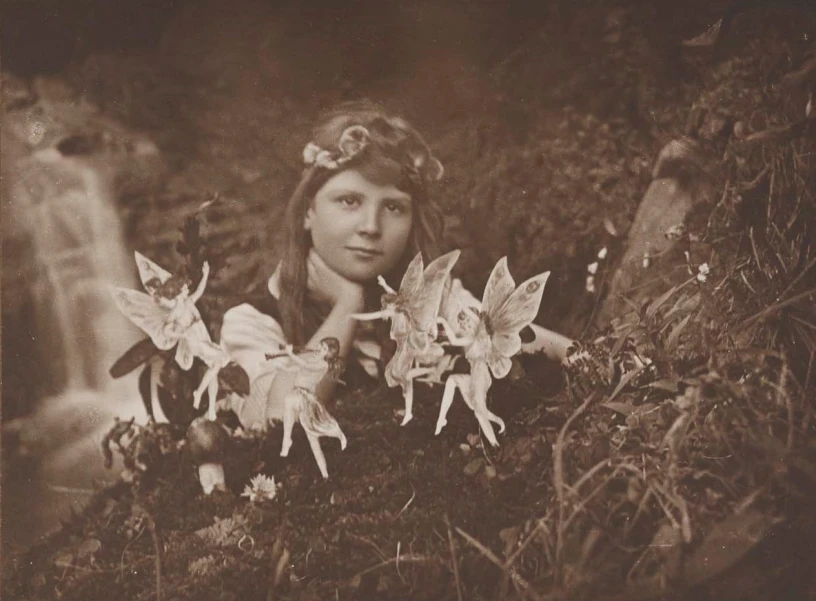
Elsie Wright and Frances Griffiths were children when they created a series of sophisticated photographic fakes claiming to prove the existence of fairies. Frances, aged 9, was admonished by her mother for coming home with wet shoes. She claimed the reason for it was she had ‘gone to see the fairies.’ When her mother disbelieved her, Elsie, her 16 year old cousin, chimed in that she had seen the fairies too. Elsie claimed she could prove it, and borrowed her father’s camera. Within a half hour Elsie returned “triumphant” with a single exposed plate. Upon development, the negative revealed to her father an image of Elsie posing with the fairy folk in the Cottingly Glen. Due to the suspicion of the adults around them, the girls created several more images. As the images were shared, many began to express their belief in their authenticity, and spoke out for their veracity. Even Sir Arthur Conan Doyle, creator of the world’s greatest detective, Sherlock Holmes, believed these photos to be evidence of the existence of Fairies. The girls, not wanting to embarrass the likes of Doyle kept their deception a secret for over six decades, never letting on that the fairy creatures were made with paper cutouts of Elsie’s drawings. Elsie finally confessed that the images were faked in 1983, although she claimed until her death that she and Frances were telling the truth about seeing the fairies.
V. Joseph Stalin walking with Vyacheslav Molotov (left) and Nikolai Yezhov (right), Moscow. (1937)
.jpeg)
Joseph Stalin was famous for disappearing his enemies through purges of both, top secret and highly public executions. Knowing the power of photography, Stalin also became infamous for erasing his enemies from the public record. In the first image above, Stalin is pictured walking with Nicolai Yezhov, an official of the secret police. Yezhov accused and executed thousands of Communist Party officials at the behest of Stalin. When Yezhov eventually fell out of favor, he too was executed, and in turn erased from Stalin’s official photographic record of history.
VI. John Kerry & Jane Fonda Election Controversy. (2004). 1971 & 1972.
.png)
During the 2004 presidential election a photo surfaced of John Kerry and Jane Fonda speaking together at a Vietnam anti-war rally. It was published by many media outlets, including the New York Times. Fonda had outraged many Americans for appearing sympathetic to the North Vietnamese, denouncing the U.S military, and visiting Hanoi during the war. The image turned out to be a fake, intended to discredit Kerry by associating him with Fonda. When the original image of Kerry was released to prove the forgery, many right wing pundits claimed the original was the fake, and the doctored photo was the real thing.
VII. “Situation Room” (2011) by Pete Souza.
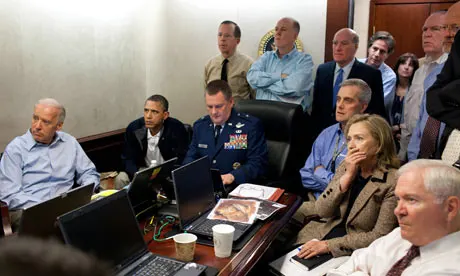
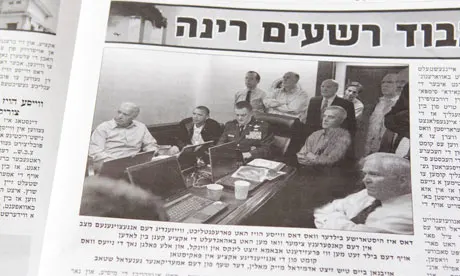
Speaking of erasing people, Hillary Clinton was digitally removed from Pete Souza’s famous “Situation Room” photograph by an Orthodox Jewish Newspaper. The Brooklyn newspaper, Di Tzeitung, altered the iconic photograph showing President Barack Obama and his staff during the raid that killed Osama bin Laden. Clinton was removed from the photo, as it was against the newspaper’s editorial policy to publish images of women. This act drew widespread criticism. Not only did they disappear Clinton from the photo, they also removed counterterrorism director, Audrey Tomason. The paper later acknowledged it, “should not have published the altered picture”.
VIII. “Protester runs past burning cars and buildings on Chicago Avenue in St. Paul, Minnesota.” (2020) by John Minchillo.
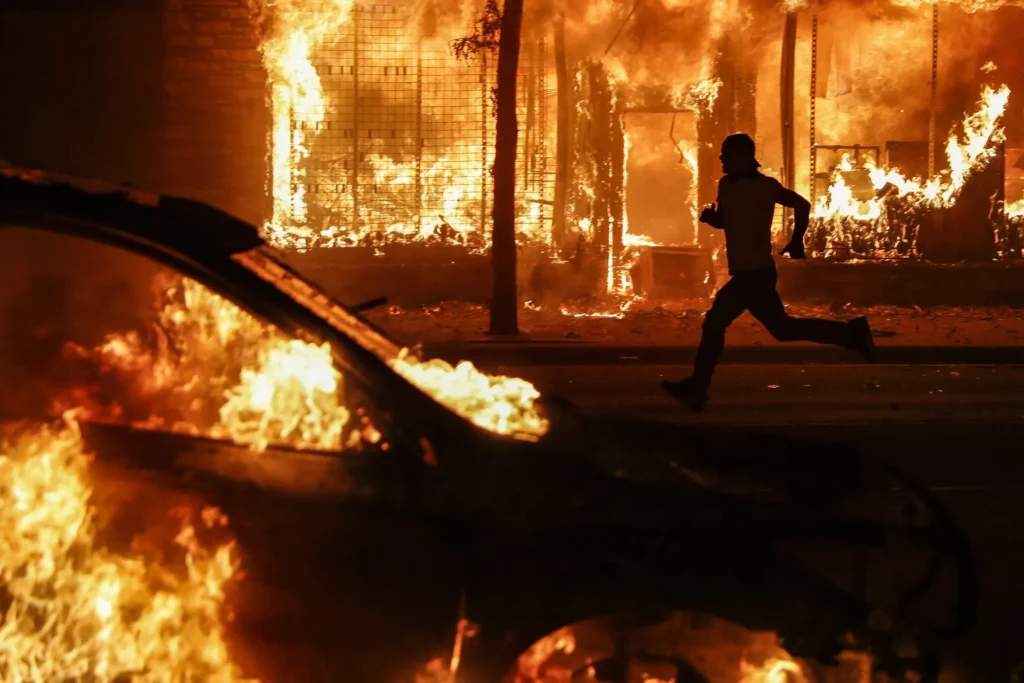
Another way photography can mislead is through captioning. Not all fakes are done with photo manipulation. For example, Fox News in 2020 ran a group of stories about Seattle activists seizing several city blocks during protests over the killing of George Floyd by a Minneapolis police officer. Along with a couple doctored photos showing gunmen that had been photoshopped into the images, they displayed a harrowing photo of a city on fire under the headline “CRAZY TOWN.” In truth, the photo was not from the Seattle protests at all, but was actually an image from a fire in St. Paul Minnesota.
***
THE AI TOOLS I USE RIGHT NOW FOR IMAGE MAKING & PHOTOGRAPHY:
Lightroom & Photoshop – With the new AI capabilities embedded in Lightroom & Photoshop you can make precise selections, remove distracting elements, add AI generated imagery, expand image frames, and more.
Aftershoot – This AI can cull and edit photos. I use the culling feature of this one to help me sort through hundreds and even thousands of photos quickly to pick the best shots. (Use this affiliate link for 10% off your first annual subscription).
Imagen AI – This AI also culls and edits photos. I use this AI for editing. Trained on a large dataset of my own photography, this AI can mimic my editing decisions and performs these edits at lightning speed. (Use this affiliate link for 1500 free photo edits).
Evoto – Quick photo editing & retouching.
Midjourney – Image generation through text prompts.
Magnific AI – Upscaling & Enhancing Photos (this one is excellent, but expensive at $30 a month).
Topaz Labs Gigapixel AI – Less expensive upscaling than Magnific AI, but without all the bells & whistles ($99 flat).
Topaz Labs DeNoise AI – Noise reduction and more.
Topaz Labs Sharpen AI – Photo sharpening.
***
Article & Photography by Jonas Seaman.
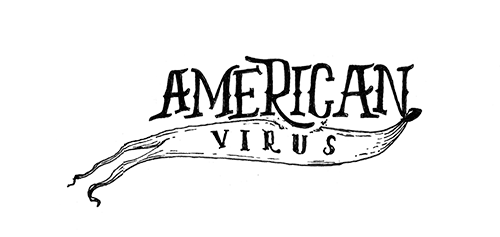


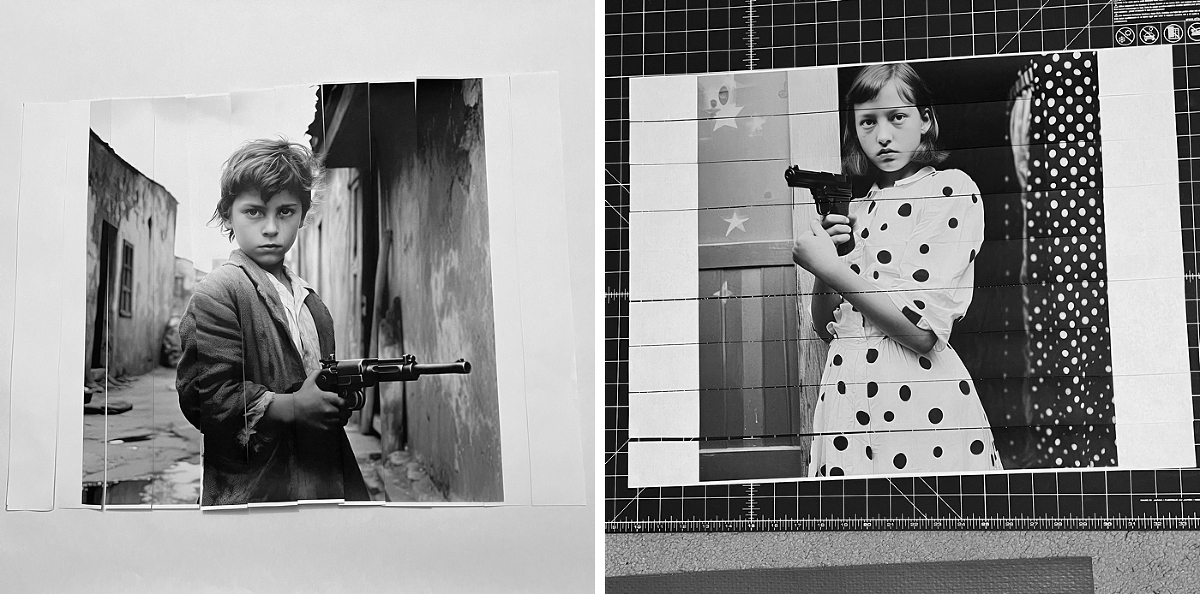



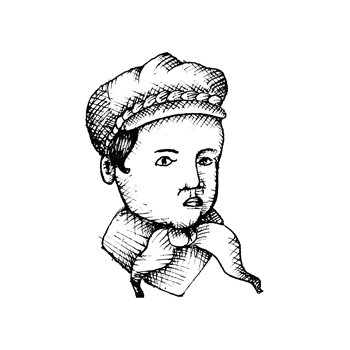





Great article and some interesting collage work. I must admit very mixed feelings about the entire Age of AI we’re currently going through, but your thoughtful musings on the current state of things for photographers are very enlightening. I do worry that more and more people will simply mass-capture images and data via fixed or robotic cameras and then have the AI edit together the event from that, limiting the need for human witnesses. But, as you say, that is probably a ways off yet.Thanks for this! It takes courage in this current climate for an artist to publicly dip their toes into this pool.
This was a great read, Jonas. The Afterthoughts were a particularly nice touch and the collages, which I first thought odd, ultimately were incredibly mesmerizing as I continued to view them.
I can understand the feelings of trepidation I hear expressed talking to people about AI, but lest we miraculously lose our desire to critically think and engage ourselves in society, the concerns are I feel are overstated. The photographer and writer for example will always have the advantage of being there and depicting what was and not just what could be.